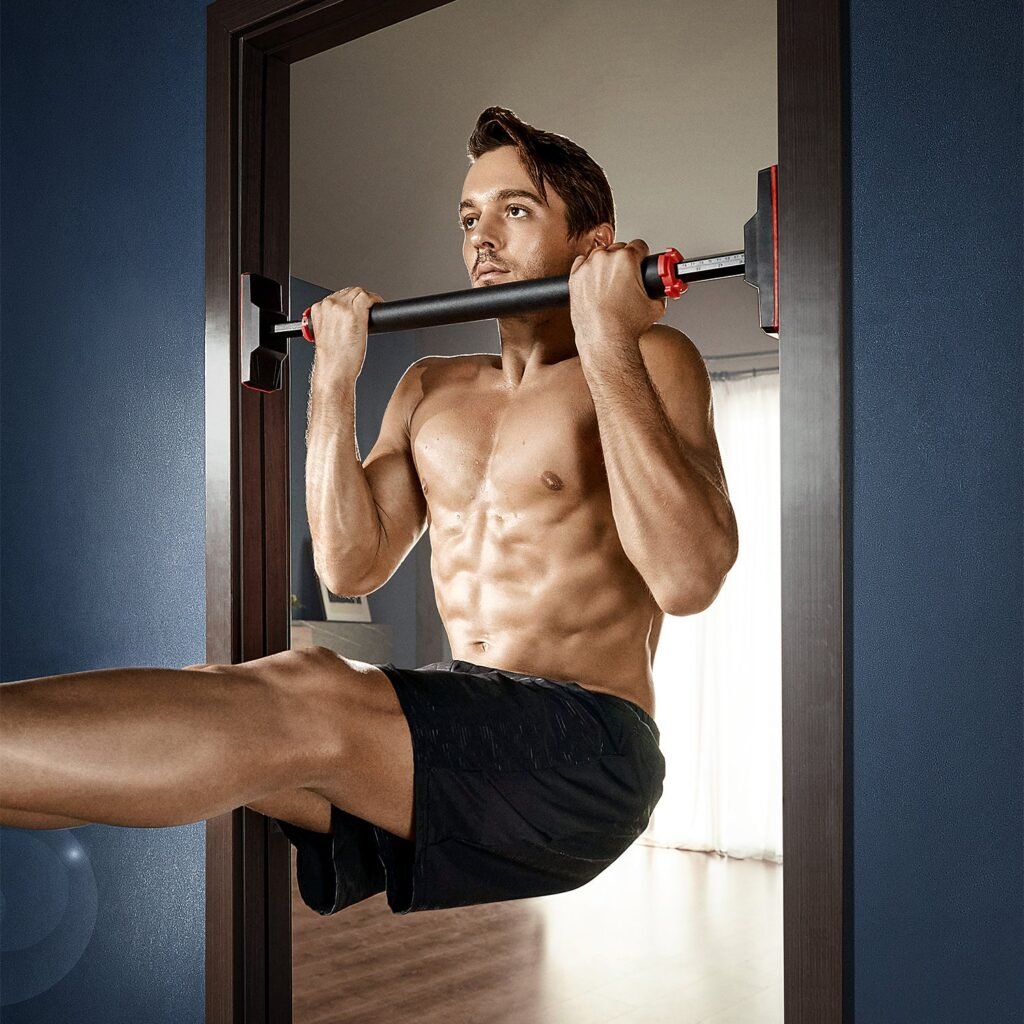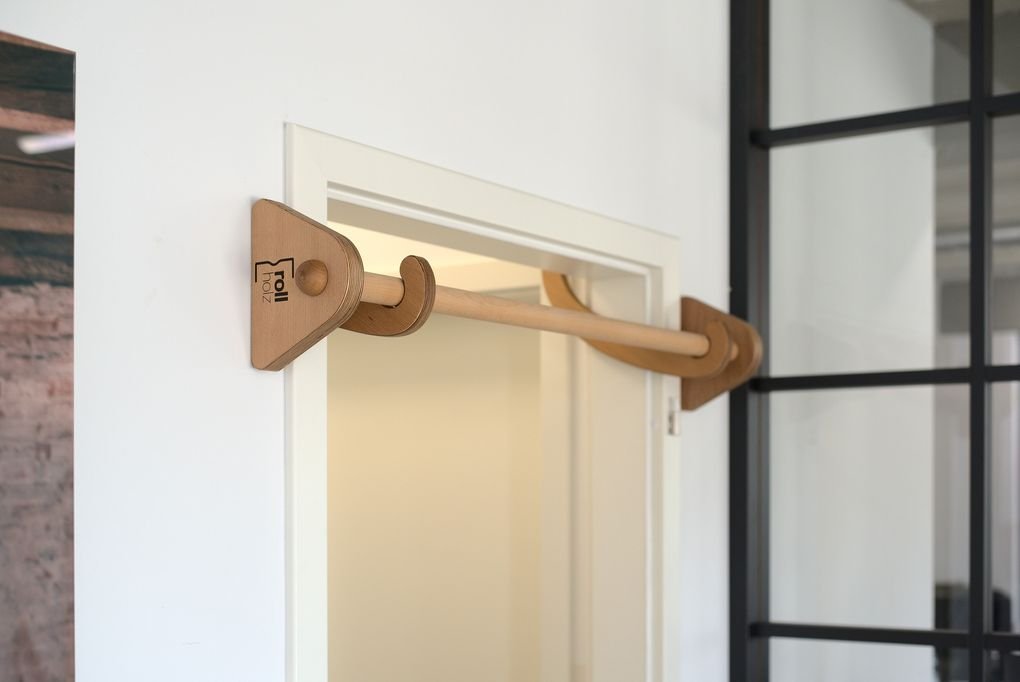A doorway pull up bar is a versatile piece of fitness equipment designed to be installed in the frame of a standard doorway. Its fundamental structure typically comprises a sturdy horizontal bar and two mounting brackets or foam padding, allowing it to leverage the doorframe for support without requiring permanent installation. This makes it an accessible option for those looking to incorporate strength training into their home workouts without the necessity of dedicated gym space.
This exercise tool offers a simple yet effective means of executing pull-ups, a classic upper body workout that targets the back, biceps, and shoulders. The design usually accommodates various grip styles, making it possible to perform multiple pull-up variations, including wide grip, close grip, and neutral grip pull-ups. Some doorway pull-up bars even feature adjustable widths or multiple grip handles, enhancing their versatility and enabling users to target different muscle groups efficiently.
Beyond traditional pull-ups, doorway pull-up bars can be utilized for an array of exercises. For instance, they can serve as support for inverted rows, leg raises, and even various hanging exercises that engage the core. This multifunctionality enables users to create a well-rounded workout regimen, combining strength training with bodyweight exercises. Moreover, the convenience of a doorway pull up bar allows users to design their fitness routines according to individual goals, making it a personalized tool for muscle building and endurance training.

In essence, the doorway pull up bar stands out as a user-friendly, space-efficient solution for enhancing strength training routines at home. With various options available and the ability to perform multiple types of exercises, it appeals to fitness enthusiasts of all experience levels, from beginners to seasoned athletes.
Benefits of Using a Doorway Pull Up Bar
Incorporating a doorway pull up bar into your fitness routine offers a multitude of advantages that can significantly enhance your physical health and exercise experience. One of the primary benefits is the development of upper body strength. Regular use of pull-up bars engages multiple muscle groups, particularly the back, shoulders, and arms, promoting overall muscular development. As users perform pull-ups or variations of the movement, they target key areas such as the latissimus dorsi, biceps, and trapezius, leading to improved muscular balance and upper body definition.
Another significant advantage of the doorway pull up bar is the improvement of grip strength. As you pull your body upward, your grip must work in tandem with the muscles of the back and arms. This increase in grip strength can be beneficial in numerous other exercises, translating to better performance in workouts that involve lifting weights or performing bodyweight exercises.
Furthermore, utilizing a pull-up bar is not only about building strength but also about efficient muscle growth that can be sustained over time. The versatility of exercises that can be performed—such as chin-ups, neutral-grip pulls, and leg raises—allows individuals to develop muscles from various angles, aiding in hypertrophy and overall fitness progression.
Beyond the physiological benefits, doorway pull-up bars provide practical advantages as well. These fitness tools are incredibly space-saving since they can be easily mounted within a doorway and removed just as effortlessly. This characteristic makes it possible for individuals to establish a workout area in even the smallest of living spaces. Additionally, the affordability of pull-up bars as opposed to purchasing larger gym equipment makes them a cost-effective solution for home workouts. This convenience allows users to maintain consistency in their fitness regimes, as they can integrate workouts seamlessly into their daily lives, promoting long-term health and wellness success.
How to Properly Install a Doorway Pull Up Bar
When it comes to installing a doorway pull up bar, proper execution is essential to ensure safety and functionality. The first step is to measure your door frame. Use a measuring tape to identify the width and height of the frame; it should be at least 32 inches wide to accommodate most pull-up bars. After confirming the dimensions, check the door frame’s structure, making sure it is sturdy and free of any cracks or damages that could compromise its integrity during use.
Next, follow the manufacturer’s instructions which typically outline the necessary tools for installation. Commonly, you will need a drill, a level, and an adjustable wrench. For bars that require drilling, mark the locations for the screws based on your measurements. Ensure that you are drilling into solid wood or reinforced metal for optimal stability. If your doorway pull up bar features a no-drill design, make sure it is correctly aligned with the door frame and firmly positioned against the wall.
It is imperative to pay attention to the weight limits specified by the manufacturer. Most doorway pull up bars can support a weight range of 250 to 300 pounds, depending on the model. Always verify that your weight does not exceed this limit to avoid accidents. After positioning the bar according to the guidance provided, use a level to ensure it is straight before securing it completely.

Before engaging in workouts, perform a thorough safety check. Test the installation by applying gradual pressure before performing any exercises, ensuring the bar stays steady and secure. Moreover, consider implementing visual aids, such as diagrams or online videos, to reinforce your installation process. By following these guidelines, you can confidently set up your doorway pull up bar and enjoy its benefits while minimizing risks.
Effective Workouts Using a Doorway Pull Up Bar
The doorway pull up bar is a highly versatile piece of equipment that can significantly enhance your workout routine. It primarily targets the upper body, strengthening muscles in the back, arms, and shoulders. To get the most out of your pull-up bar, incorporating different exercises can help you build muscular endurance and strength effectively.
One of the most common exercises is the standard pull-up. This exercise typically requires you to grasp the bar with an overhand grip, pulling your body up until your chin surpasses the bar. Variations such as the wide grip pull-up offer increased difficulty by engaging the lats and broadening the range of motion. Conversely, chin-ups focus on pulling with an underhand grip, effectively engaging the biceps more intensely.
Adding exercises like leg raises and hanging knee raises to your routine can enhance core stability. When performing leg raises, engage your core as you lift your legs towards your chest while hanging from the bar. This movement not only strengthens your abs but also complements the upper body work done during pull-ups.
To create a balanced workout routine, consider integrating sets and repetitions that align with your fitness level. Beginners might start with 2 to 3 sets of 5 to 10 reps, while more experienced individuals can challenge themselves to complete 4 to 5 sets with 10 or more reps per set. Progression techniques, such as increasing your rep count or extending the duration of hanging leg raises, will help you foster steady improvements over time.
Incorporating rest days into your workout schedule is crucial for recovery. This will help build strength without risking injury, allowing you to regularly track your progress. By utilizing the doorway pull up bar effectively, you can maximize your workout sessions and achieve significant physical gains.

